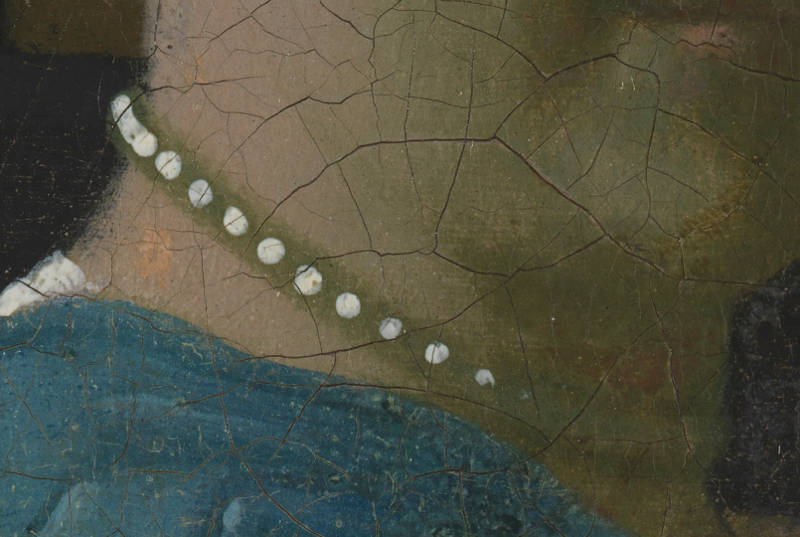Painting Pearls

Johannes Vermeer
c. 1670–1673
Oil on canvas, 51.7 x 45.2 cm.
National Gallery, London
In the late Lady Standing at a Virginal, Vermeer experimented with an original technique to depict the lady's pearl necklace. The degree to which the artist was able to distill the necklace's optical and physical properties with crude paint and brush is as daring in concept and execution as it is efficient.Perhaps, this pictorial solution was suggested by the aberrations produced by the images of unfocused camera obscura
Conceptually, for Vermeer, the demure musician's necklace was not so much an inventory of individual pearls held together with an unseen string, but an instantaneous, visual impression of a graceful, luminous accouterment, intimately bound to the lady who had the fortune to wear it.
The peculiar technique he devised to realize his impression seems not to have been adopted by any other Dutch painter, even the great painting technician, Rembrandt van Rijn.
To describe the hang of the lady's necklace and provide a base for the further definition, Vermeer first painted a thin elliptical band of light gray paint (probably wet in wet) into the light pink paint of the musician's neck. The contours of the gray band were delicately blended with the surrounding pink paint although the shapes of the individual pearls are completely ignored.
The softness of the band's contours suggests the pearls' unique, translucent nature, allowing the necklace, as it were, to delicately dissolve into the lady's tender flesh.

Rembrandt van Rijn
c. 1639
Oil on panel, 107 x 82cm.
Rijksmuseum, Amsterdam
After the band of gray paint was thoroughly dry, Vermeer applied a sequence of nine perfectly globular daubs of thick, white paint at regular intervals in order to represent the highlight of the pearls that are exposed to direct light. The high relief of the highlights, brighter than any other passage of the painting, causes them to "stand up" from the flat surface of the canvas. From normal viewing distance, they appear almost like tiny points of natural light rather than dots of paint. As the pearls draw near to the left-hand contour of the lady's neck, the highlights begin to superimpose themselves upon the one another capturing the impression that the necklace wraps around and behind the lady's neck.
In this passage, Vermeer demonstrates his extraordinary ability to evoke the essential optical and poetic properties of pearl necklace. In addition, he confronts the spectator with the means by which this tiny illusion is achieved. The spectator is draw deeper into his undeclared mystery because he is constrained to question what he is really looking at: pearls or paint?
It may be no exaggeration to say that this passage, a veritable pictorial sleigh of hand, is one of the most sophisticated achievements of the work, conceptually out of reach of Vermeer's most talented colleagues.
